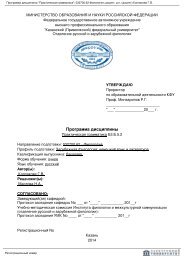Following Best Practice in the High Art of - (Приволжский ...
Following Best Practice in the High Art of - (Приволжский ...
Following Best Practice in the High Art of - (Приволжский ...
You also want an ePaper? Increase the reach of your titles
YUMPU automatically turns print PDFs into web optimized ePapers that Google loves.
'target doma<strong>in</strong>s', '<strong>in</strong>variance', 'mapp<strong>in</strong>gs', and so forth have become a<br />
common, though not universal, vocabulary for discuss<strong>in</strong>g <strong>the</strong><br />
l<strong>in</strong>guistic and conceptual phenomena <strong>of</strong> metaphor. The f<strong>in</strong>d<strong>in</strong>gs and<br />
pr<strong>in</strong>ciples <strong>of</strong> this framework have been applied <strong>in</strong> numerous studies,<br />
both with<strong>in</strong> and outside <strong>of</strong> <strong>the</strong> field <strong>of</strong> l<strong>in</strong>guistics.<br />
A more recent framework, proposed by Fauconnier and Turner<br />
(1994; 1998) seeks to expla<strong>in</strong> much <strong>of</strong> <strong>the</strong> same l<strong>in</strong>guistic data, and<br />
also to unify <strong>the</strong> analysis <strong>of</strong> metaphor with <strong>the</strong> analysis <strong>of</strong> a variety <strong>of</strong><br />
o<strong>the</strong>r l<strong>in</strong>guistic and conceptual phenomena. This framework, referred<br />
to variously as <strong>the</strong> <strong>the</strong>ory <strong>of</strong> 'blend<strong>in</strong>g', 'conceptual blend<strong>in</strong>g', and<br />
'conceptual <strong>in</strong>tegration', shares many aspects <strong>of</strong> conceptual metaphor<br />
<strong>the</strong>ory (CMT). For <strong>in</strong>stance, both approaches treat metaphor as a<br />
conceptual ra<strong>the</strong>r than a purely l<strong>in</strong>guistic phenomenon; both <strong>in</strong>volve<br />
systematic projection <strong>of</strong> language, imagery and <strong>in</strong>ferential structure<br />
between conceptual doma<strong>in</strong>s; both propose constra<strong>in</strong>ts on this<br />
projection; and so forth.<br />
However, <strong>the</strong>re are also important differences between <strong>the</strong><br />
approaches: CMT posits relationships between pairs <strong>of</strong> mental<br />
representations, while blend<strong>in</strong>g <strong>the</strong>ory (BT) allows for more than<br />
two; CMT has def<strong>in</strong>ed metaphor as a strictly directional<br />
phenomenon, while BT has not; and, whereas CMT analyses are<br />
typically concerned with entrenched conceptual relationships (and <strong>the</strong><br />
ways <strong>in</strong> which <strong>the</strong>y may be elaborated), BT research <strong>of</strong>ten focuses on<br />
novel conceptualizations which may be short-lived. In this article we<br />
explore <strong>the</strong> relationship between BT, CMT and <strong>the</strong> phenomena <strong>the</strong>y<br />
address, argu<strong>in</strong>g that <strong>the</strong> two approaches are complementary. In<br />
particular, <strong>the</strong> cross-doma<strong>in</strong> relationships which have been identified<br />
by CMT researchers shape and constra<strong>in</strong> <strong>the</strong> more complex process<br />
<strong>of</strong> conceptual blend<strong>in</strong>g. The nature <strong>of</strong> this relationship has relevance<br />
for anyone <strong>in</strong>terested <strong>in</strong> <strong>the</strong> conceptual analysis <strong>of</strong> language and,<br />
more broadly, for anyone <strong>in</strong>terested <strong>in</strong> conceptual structure.<br />
Problem Outl<strong>in</strong>e L<strong>in</strong>guistics, def<strong>in</strong>ed as <strong>the</strong> study <strong>of</strong> language,<br />
comprises <strong>of</strong> many different fields <strong>of</strong> <strong>in</strong>vestigation. Some branches<br />
focus on particular languages <strong>in</strong> turn and <strong>the</strong>ir <strong>in</strong>ternal structure, such<br />
as morphology or syntax, whereas o<strong>the</strong>rs attempt a broader placement<br />
<strong>of</strong> language use <strong>in</strong> contexts, such as sociol<strong>in</strong>guistics, focus<strong>in</strong>g on <strong>the</strong><br />
relations between language and society, or psychol<strong>in</strong>guistics, which<br />
<strong>in</strong>vestigates <strong>the</strong> ties between language and <strong>the</strong> human bra<strong>in</strong>. Each <strong>of</strong><br />
<strong>the</strong>se different approaches pursues <strong>the</strong> study <strong>of</strong> language <strong>in</strong> its own<br />
way, and <strong>the</strong>y do not always agree what exactly <strong>the</strong> term 'language'<br />
means.<br />
This apparent confusion is also obvious <strong>in</strong> <strong>in</strong>troductory textbooks on<br />
l<strong>in</strong>guistics, <strong>in</strong> <strong>the</strong> lack <strong>of</strong> def<strong>in</strong>itions given for 'language'. The notion<br />
<strong>of</strong> look<strong>in</strong>g at one particular language and <strong>in</strong>vestigat<strong>in</strong>g <strong>the</strong> patterns <strong>in</strong><br />
which sounds, phonemes, morphemes, words, phrases, and sentences<br />
comb<strong>in</strong>e to form mean<strong>in</strong>gful utterances with<strong>in</strong> <strong>the</strong> framework <strong>of</strong> that<br />
28<br />
деятельности;<br />
(2)смешивание/<br />
сочетание;<br />
(3)образность;(4)логически<br />
выведенный;<br />
(5)укрепленный;<br />
(6)дополнительный/<br />
добавочный;<br />
(7)внутренняя<br />
структура;<br />
(8)содержательные



